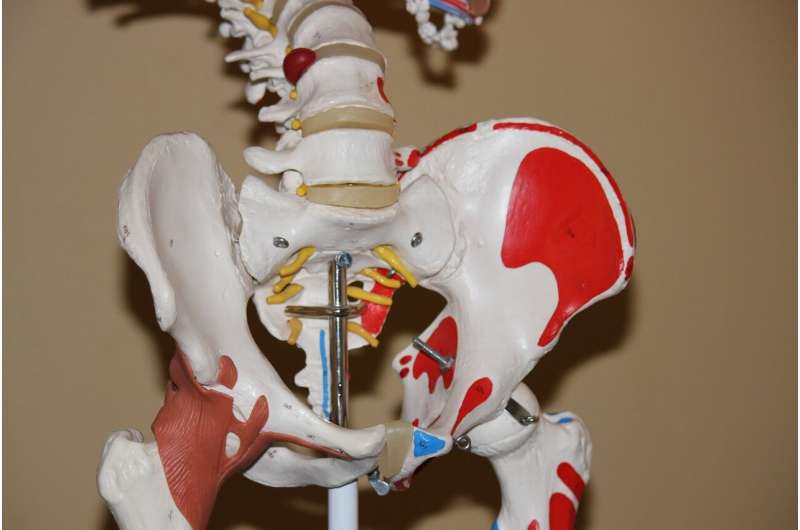This article has been reviewed according to Science X's editorial process and policies. Editors have highlighted the following attributes while ensuring the content's credibility:
fact-checked
peer-reviewed publication
trusted source
proofread
Comprehensive new Canadian guideline for skeletal health and fracture prevention

A comprehensive guideline from Osteoporosis Canada aims to help primary care professionals deliver care to optimize skeletal health and prevent fractures in postmenopausal females and males who are age 50 years and older. It is published in CMAJ (Canadian Medical Association Journal).
With 25 recommendations and 10 good practice statements, this update to the 2010 guideline contains sections on exercise, nutrition, fracture risk assessment, treatment and more, reflecting advances in risk assessment, and nonpharmacologic and pharmacologic management of osteoporosis.
In Canada, there are more than 2 million people living with osteoporosis, defined as bone mineral density (BMD) at a level below peak bone mass, which increases risk of fracture. Fractures usually occur after a fall and can affect the hip, wrist, arm and spine, in particular.
"We are hopeful that this Canadian guideline will empower health care professionals and patients to have meaningful discussions on the importance of skeletal health and fracture prevention to preserve mobility and autonomy across adulthood," says Dr. Suzanne Morin, lead author and chair of the guideline steering committee.
The guideline is based on the latest evidence and included patient partners in developing the recommendations.
Key points:
- Prior fracture is a strong risk predictor of subsequent fracture (particularly in the subsequent 12–24 months); however, other risk factors are also important to identify individuals who would benefit from pharmacotherapy.
- The management of osteoporosis should be guided by the patient's risk of fracture based on clinical assessment, including risk for falls, and using a validated fracture risk assessment tool.
- Exercise, nutrition, fall prevention and pharmacotherapy are key elements of the management strategy for fracture prevention, and should be individualized.
- Clinicians and patients should collaborate in developing care plans that consider patients' priorities and preferences.
The guideline emphasizes key components to ensuring bone health and contains several recommendations for patients, including the following:
Exercise
- Balance and functional training at least twice a week to reduce the risk of falls
- Progressive resistance training at least twice a week, including exercises targeting abdominal and back extensor muscles
"Create a plan to do balance, functional, and strength training twice a week or more to prevent falls and fractures and improve functioning and quality of life," advises Dr. Lora Giangregorio, a co-author and chair of the Exercise Working Group. "Progress the difficulty of the exercise program over time and monitor your progress."
Nutrition
- For people who meet the recommended dietary allowance for calcium with a variety of calcium-rich foods, no supplementation to prevent fractures is needed.
- Follow Health Canada's recommendation on vitamin D for bone health: 600 IU/d (age 51–70 yr) and 800 IU/d (age > 70 yr) for males and females.
Fracture risk assessment
- A clinical assessment for osteoporosis and fracture that includes identifying risk factors and assessing for signs of undiagnosed vertebral fracture(s). This includes BMD testing in postmenopausal females and males who are
- aged 50–64 years with a previous osteoporosis-related fracture or ≥ 2 clinical risk factors OR
- aged ≥ 65 years with 1 clinical risk factor for fracture OR
- aged ≥ 70 years
Pharmacotherapy is an important component of fracture prevention management and should be individualized.
Other guidelines
A guideline from the Canadian Task force on Preventive Health Care published in spring 2023 based on randomized controlled trials (RCTs) recommends risk assessment–first screening for the primary prevention of fragility fractures in females aged 65 years and older using the Fracture Risk Assessment Tool without BMD.
The task force guideline recommends against screening younger females and males of any age. The Osteoporosis Canada guideline differs as it included a range of studies in addition to RCTs and several studies included men. The new guideline recommends screening in men and younger women, in contrast to the task force guideline.
"Identification and appropriate management of skeletal fragility in Canadians can reduce fractures, and preserve mobility, autonomy and quality of life in this population," says Dr. Morin.
More information: Suzanne Morin et al, Clinical practice guideline for management of osteoporosis and fracture prevention in Canada: 2023 update, Canadian Medical Association Journal (2023). DOI: 10.1503/cmaj.221647, www.cmaj.ca/lookup/doi/10.1503/cmaj.221647




















